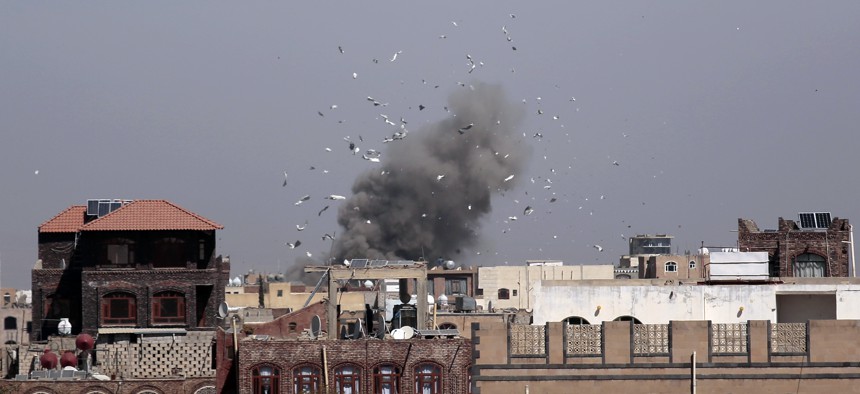
Debris and smoke rise after a Saudi-led airstrike hit an army base, in Sanaa, Yemen, on Jan. 22, 2017. AP Photo / Hani Mohammed
Don’t Blame Trump for the Yemen Raid’s Outcome
There’s more to the story, from special operators who chafed at Obama administration micromanagement to the unexpected well-prepared enemies who lay in wait.
Blame for the Yemen raid going terribly wrong is now being placed squarely on the desk of the new president. Reports surfaced on Thursday night to say that President Trump had authorized the raid in Yemen, which targeted Al Qaeda in the Arabian Peninsula without sufficient intelligence and backup planning. Some critics of the president immediately cited the story as a sign that Trump said “yes” without a full appreciation for the life-and-death stakes of this kind of combat operation.
I have written against Trump’s immigrant ban, arguing that it places U.S. allies in Iraq, Syria, and beyond at risk and leaves America less safe, not more. But in the case of the Yemen raid, critics seem to be misunderstanding just how these missions work.
“If the commander on the ground believed the intelligence and support were insufficient, he could have aborted the mission,” wrote Chris Kolenda, a veteran of four combat deployments to Afghanistan and the former senior advisor on Afghanistan and Pakistan to the Defense Department’s senior leaders. “Trump did not force an unwilling SEAL team into a dangerous raid. He was approving what the military said should be done.”
Voices may have been missing from the room, as some say, from the State Department and intel community. That is not yet fully clear. But a lack of perspectives and a deferral to judgment of others, including Defense Secretary Mattis, is not the same as sending U.S. troops willy-nilly into a special operations mission.
The entire incident highlights the tensions inherent in planning, approving, and carrying out these missions. Over the past two years, I have heard from special operators who said the Obama White House was taking too long to approve (or reject) some life-or-death missions. And now the Trump administration is facing a barrel of questions about whether it moved too quickly and without enough information.
The bloody civil war continues to claim lives in Yemen. The United States is not directly involved in the war, but working with UAE special operations forces to pursue Al Qaeda targets. This special operations mission began as a “short-term” one and was extended “indefinitely” last July.
Right now, special operations forces are facing extremely high demands on both their time and their skill set. In December, a report from the Center for Strategic and International Studies noted that as these specialized troops “became increasingly involved in counter-terror operations, the demands on special operations forces created historically high rates of deployment. During any single year, SOF are deployed to nearly 75 countries around the globe, with some operations requiring up to a dozen raids each evening.”
The pace only escalated under the Obama administration. Indeed, planning for last week’s Yemen mission began during its final months.
Under Obama, the State Department and the intel community both helped to decide whether to approve strikes, a process that frequently, but not always, required White House approval.
“The Obama White House tended to approach this from a perspective of ‘Let’s make sure we don't get this wrong, even if we miss an opportunity,’” says Luke Hartig, who served as Senior Director for Counterterrorism at the National Security Council under Obama. “There are merits and downsides to that.”
As it happens, Obama White House officials reviewed the operation, but deferred the ultimate decision until local conditions allowed for it.
The mission — approved by President Trump — began badly and ended tragically, starting with the crash of the Osprey — which is now becoming known as a “hard landing.” And that was just the start of a raid that went terribly wrong, killing at least 10 civilians, including an eight-year-old American girl, and taking the life of Navy SEAL William “Ryan” Owens.
But what the narrative of this mission gone awry misses is that special operations had long chafed under the Obama White House. I spent months last year talking to people inside the special operations community and the Pentagon. Many said the administration micromanaged operations, down to the helicopter used. Some who took part in daring raids to rescue hostages and find Al Qaeda and ISIS leaders told me the White House moved too slowly in life-and-death situations.
So with the arrival of a new president, there was some sense among those in the community that up-or-down decisions would arrive more quickly. And when conditions were right, the Yemen operation was briefed to and approved by Trump in relatively short order. But what was not foreseen was how well prepared the enemy would be when U.S. forces arrived, and just how wrong things would go.
As one special operations source told me this week, “The enemy always has a say.”
Now the question is: what happens next? Will the White House continue to defer and say yes when its approvals are sought for these kinds of special operations missions? And what, exactly, is the U.S. mission in Yemen?
The answers are, as yet, unknown. But what is certain is that more of these missions lie ahead.
NEXT STORY: How to Survive a Russian Hack




